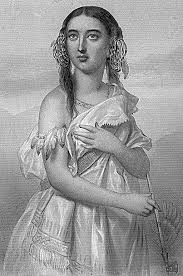Tsenacommacah: The Forgotten Realm of the Powhatan
Long before English settlers landed in Jamestown in 1607, a powerful Indigenous realm stretched along the coast of Virginia: Tsenacommacah, homeland of the Powhatan Confederacy. Under the leadership of Wahunsenacawh (Chief Powhatan), it united more than 30 Algonquian-speaking tribes – a political masterpiece the European newcomers could hardly comprehend.
The Real Pocahontas: Diplomat, Not Princess
The girl we know as Pocahontas was actually named Matoaka (“the Playful”). As the daughter of the powerful Chief Wahunsenacawh, she was not a romantic princess but a political mediator in a time of dramatic change. Her legendary “intervention” to save John Smith was likely an adoption ritual, not a romantic gesture.
“My ancestor was a diplomat navigating between worlds,” says Ashley Atkins, a descendant of the Powhatan. “She sacrificed her personal freedom to protect her people. That is the true story, not the Disney fairytale.”
Cultural Flourishing: Life in Harmony with the Chesapeake Bay
The Powhatan mastered their environment with impressive efficiency:
- Three Sisters Agriculture: Corn, beans, and squash in symbiotic planting
- Seasonal Movements: Winter camps inland, summer villages on the coast
- Complex Trade Networks: Stretching from the Appalachians to the Atlantic coast
The Collapse: Disease, War, and Displacement
The arrival of the English triggered a demographic catastrophe. Imported diseases like smallpox decimated the population by up to 90%. The wars of 1622 and 1644 destroyed the Confederacy’s political structure once and for all.
“Within two generations we lost everything,” recalls a Pamunkey elder. “Our land, our political autonomy, even the freedom to raise our own children.”
Centuries of Resistance: Invisible Survival
Despite official claims of their “disappearance,” Powhatan communities survived in the shadows. They adapted, safeguarded their knowledge in secret, and intermarried strategically to preserve their identity.
Struggles for Recognition: The Long Road to Sovereignty
Only in 2016 did the Pamunkey become the first Virginia tribe to receive federal recognition – after a 35-year battle. The Mattaponi, Chickahominy, and other Powhatan descendants soon followed.
“Recognition was not a gift, but the confirmation of what we always knew: We are still here,” emphasizes Chief Robert Gray of the Pamunkey Nation.
Cultural Renaissance: The Return of the Language
The Powhatan language, thought extinct for almost two centuries, is experiencing a remarkable revival. Using historical records from John Smith and William Strachey, linguists and community members are reconstructing the lost vocabulary together.
“Every word we reclaim is a victory against cultural genocide,” says language activist Buck Woodard. “When we say ‘renepo’ (person), we connect directly with our ancestors.”
Modern Challenges: Between Tradition and Tourism
Today, Powhatan descendants face complex challenges:
- Protecting sacred sites from commercial development
- Balancing cultural sharing with protection against appropriation
- Economic development without losing cultural identity
Pocahontas’ Legacy: From Legend to Teacher
For today’s Powhatan, Pocahontas is not a fairytale figure but a lesson in resilience. “Her fate reminds us of the price of survival,” says historian Dr. Angela Daniel. “But also of the duty to tell our own story.”
Future Perspectives: The Next 400 Years
Young Powhatan activists now use modern tools for ancient goals: social media for cultural revitalization, legal scholarship for land reclamation, environmental science to protect sacred waters.
“We are writing the next chapter of our history,” says young artist Ashley Sheppard. “Not as victims, but as creators of our future.”
What Remains: The Unbroken Bond with the Land
Despite all losses, the Powhatan have preserved one thing: their deep connection to Tsenacommacah. The rivers their ancestors navigated, the forests that sustained them, the coasts they protected – this land remains their home.
“When I see the James River, I don’t just see water,” says a Mattaponi elder. “I see the tears of my ancestors, but also their hopes. The river remembers, even when people forget.”
What do you think about the gap between the Pocahontas legend and historical reality? Share your thoughts in the comments!
Further resources:
Pamunkey Nation Museum
Virginia Indian Program
National Museum of the American Indian – Powhatan Exhibit

